Falling for India

Leaving behind the comforts of his home in suburban Atlanta, KYLE PATEL spent a year in rural Gujarat during his stint as a Fulbright Fellow—and followed it up with a journey of a lifetime when he traveled with his family to 50 cities across India.

As I walked into the village of Vanakpore, ready to take my first interview, I was nervous. What if the patient didn’t want to talk to me? Would I really be able to ask him the kind of personal questions that I needed to? These thoughts ran through my mind as we approached the dukaan where we had been directed by villagers after asking how to find Gordhanbhai, our patient.
[Right] The author, Kyle Patel, at the railway station of Rajpardi, the town where his Fellowship study began. It also happens to be his father’s birthplace, a fated coincidence that made his work there even more special.

[Top] Kyle with Shreybhai and Gayatriben, his chief mentors at SEWA Rural. “They were instrumental to the work I did and gave me the opportunity of a lifetime.”
At the shop, a bodega typical of many Indian villages where one could find rice, dal, namkeen, and supari, among other daily staples, we found Gordhanbhai sitting behind a makeshift desk. He broke into a smile when Natubhai, the senior community health worker accompanying me, informed him that we were from SEWA Rural, and quickly pulled out a stool for me to sit down. My interview with Gordhanbhai went smoothly because he trusted SEWA deeply and felt comfortable talking to me about the intimate details of his health, finances, and personal life.
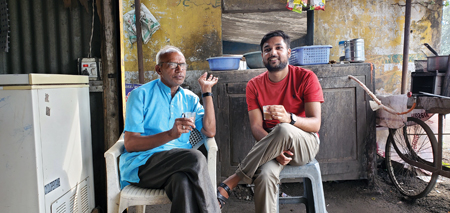
[Right] A chai break with Natubhai, “an incredible human being and skilled community health worker who accompanied me on all my field visits.”
As a Fulbright Fellow working in rural India, this was one of my first experiences in community-based healthcare. I was conducting public health research for SEWA Rural (Society for Education, Welfare and Action–Rural), an NGO that has been practicing community medicine for 40 years across the Bharuch and Narmada districts of Gujarat. Treatment is provided at their Kasturba hospital in the town of Jhagadia.
For my year-long project, I created a study to understand the health-seeking behavior of patients who were recommended cataract surgery at weekly eye camps hosted by SEWA. The objective was to determine whether patients sought treatment at our hospital after diagnosis at the camp, and what factors affected their decision-making. I interviewed them at camps and visited them at home later to comprehensively understand their health-seeking behavior. My work was quite intrusive as we were asking people why they did not seek healthcare after being diagnosed and offered free surgery. The fact that most people received us warmly, and were willing to speak with me about their health, was an incredible privilege. I realized it was possible because of the years of community building by the organization, laid down long before I had come to Jhagadia.
Stories of sorrow and loss, but also hope and appreciation
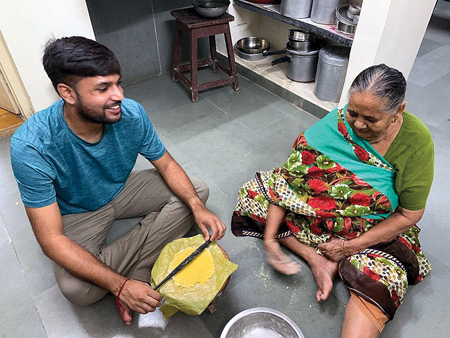 My research focused on some of the most vulnerable populations of the region: the elderly, the poor, and the tribal community. I met laborers who worked 12 hours a day for a meager 150 rupees per day. And elderly couples who had been abandoned by their children, left to spend the rest of their days in the village alone.
My research focused on some of the most vulnerable populations of the region: the elderly, the poor, and the tribal community. I met laborers who worked 12 hours a day for a meager 150 rupees per day. And elderly couples who had been abandoned by their children, left to spend the rest of their days in the village alone.
[Left] Learning how to make the “best thepla from a sweet Ba who lived in my society.”
A memorable experience was visiting Babubhai in the gam of Vali, one of the most beautiful villages I saw during my study. Natubhai and I made our way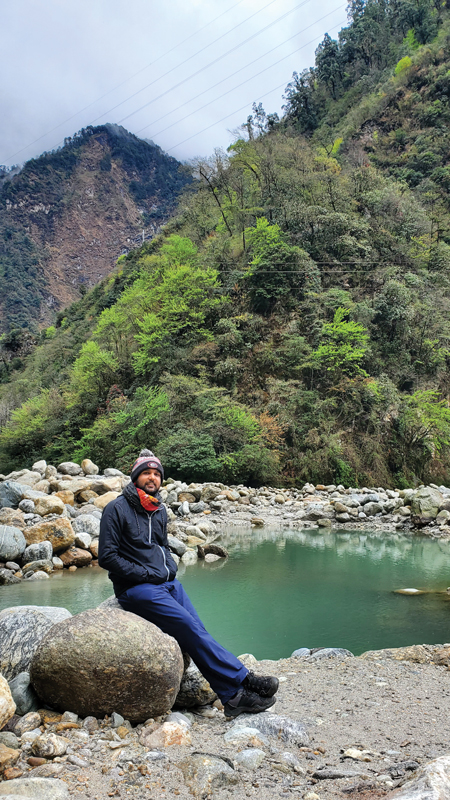 down a dirt path that opened into a plot containing the foundation of a house, with some farmland behind it. It looked like it had been abandoned mid-construction. We walked forward and saw a man sitting in a small shack beside the foundation. Babubhai’s eyes lit up when he saw us. After the usual greetings, he began telling us his story.
down a dirt path that opened into a plot containing the foundation of a house, with some farmland behind it. It looked like it had been abandoned mid-construction. We walked forward and saw a man sitting in a small shack beside the foundation. Babubhai’s eyes lit up when he saw us. After the usual greetings, he began telling us his story.
He lived alone because his wife and son had passed away years earlier. He had a daughter but they were estranged, even though she still lived in the same village. After his family had passed away, he had spiraled into bouts of alcoholism, which had made neighbors not want to associate with him—something we found out while making our rounds in the village. The construction of his house had also been stopped during this time, forcing him to live in a shack beside it.
Babubhai’s primary reason for not getting his surgery was a fear of being alone. Going to the hospital alone. Getting the surgery alone. Coming back alone. Compounding this, he had a cow that he tended to and kapaas that was just about ready to be harvested. He had no one to watch his farm and cow for the few days he needed to get the surgery. All these factors painted a picture of why our patient couldn’t get the healthcare he needed, even though SEWA would cover the surgery costs and transportation expenses.
As we left, Babubhai promised us he would find a way to get to the hospital. Our visit seemed to have motivated him, and I had some hope he would make it.
[Right] Taking in the scenery while traveling through Sikkim, Kyle’s first exposure to Northeast India and its beauty.

Kyle enjoying the beautiful views at Kalo Dungar in Kutch.
Madhuben, another patient I met, was so happy we had come to find out why she hadn’t gotten treatment yet that she decided to act right away. She came to the hospital just two days later. When I went to follow up with her after the surgery, she was sitting on her bed in the living room, wearing the dark sunglasses that all patients get after cataract surgery to protect their eyes. I felt an immediate joy, almost euphoria, and sat down to chat with her. She told me about how she wanted to go immediately after we visited her, but her daughter wasn’t free to take her. So, she took matters into her own hands and found a neighbor who also needed surgery to go with her the next day. They hailed a rickshaw and made it to the hospital.

[Left] Having one last meal with his neighbors in Jhagadia. “They helped me understand the love and joy of community.”
Many stories, like Babubhai’s and Madhuben’s, were filled with sorrow and loss, but also hope and appreciation. Most patients I met were elated that we came to visit them at their homes. They felt seen and were awed by the individual attention they were receiving for their health conditions. Throughout the study, I felt that our patients deserved the attention we were giving them, but they usually didn’t feel the same. It was a stark reminder of the gap that still exists in fulfilling the promise of healthcare as a human right and the material realities people face in meaningfully gaining access to that right.
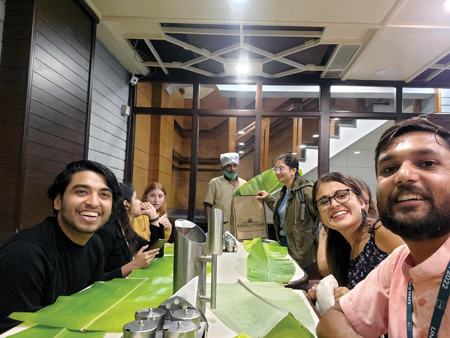

[Left] Enjoying an Andhra thali for the first time with friends he made at the UNLEASH global innovation lab in Mysore.
[Right] Drinking tandoori chai for the first time in Dharamshala. “The flavors from the kulad are delicious!”
A deep appreciation for rural India
Over the year of my fellowship, I crisscrossed the region, attending 14 camps and visiting patients in 29 villages. Most of the time, Natubhai and I found our way to a patient’s home by asking neighbors for directions along the way. With just the name of a person and their village, one can find almost anyone—a reflection of how these communities are interconnected—and many times, interdependent. I came to love this aspect of working in rural India. I can’t imagine using the same method to find someone in my neighborhood in the suburbs of Atlanta.
While conducting my interviews, I met people of many faiths, castes, and socioeconomic backgrounds. Most welcomed us with a cup of chai and curiosity about what we were doing. During this time, I came to deeply appreciate the Adivasi community as well, a group I’d never interacted with before but composed the majority of my patients and local community. The kindness and openness with which I was met gave me great happiness. And this too from individuals who had very little.

Trying his hand at block printing while visiting Jaipur.
My experience in the field gave me a glimpse of India’s beauty through its people. It also provided insight into a variety of unique cultures and identities, which not only broadened my worldview but granted me the opportunity to engage in a mutual exchange of feelings, ideas, and understanding.

Immersing into India beyond Gujarat
After finishing my fellowship, I had the privilege of traveling throughout India with my family. Combined with the places I had gone during my time as a Fulbright Fellow, I visited over 50 cities in 20 of India’s states. From the snow-capped mountains of Himachal to the soothing backwaters of Kerala to the endless hills of Nagaland, I feel that I was able to see the length and breadth of the nation. I am reminded of Tagore’s lyrics in our national anthem when I reflect on my travels and think about how rich and boundless Bhãrat is. For me, it was the experience of a lifetime.
[Left] Scenes from Kyle’s travels with his family. (a) in Arunachal Pradesh (b) at the Brihadeeswara Temple in Thanjavur (c) at Nalanda University, Bihar.
I decided to go live in India for a year because, for a while, I had felt like something within me was missing—a part of my culture, identity, and belonging that I could not discover without physically being in the place where my family comes from. During my second-ever visit to India, when I was 20, feeling like a foreigner in my own homeland was a jarring realization. Since then I longed for a connection to better understand the people and places that make India what it is. During this recent journey, I learned that our country is extremely diverse, so much so that it’s almost impossible for me to synthesize any homogenous theme from everywhere I traveled.
What I did find in each place were wonderful people who treated me like family. Beautiful landscapes that I could not stop clicking pictures of. Dance forms and musical styles steeped in centuries of practice and preservation. And thalis with a different dish in every state that showcased some essence of the place. Kangsoi in Manipur; Goan fish curry; parottas and puttu in Kerala; dal baati in Rajasthan; podi idli in Tamil Nadu; fafda in Gujarat; biryani in Hyderabad; bai in Mizoram; mishti doi in West Bengal; dosa in Mysore; and much much more.
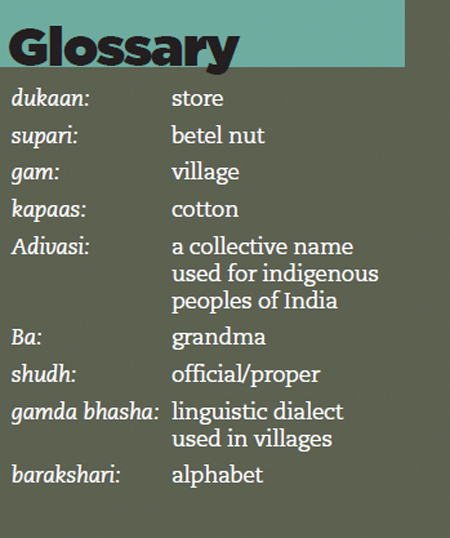
Discovering India through working, living, and traveling there allowed me to discover myself. I now have a deeper appreciation for the importance of community and identity. During my last two visits to India (out of three in all), I had the chance to visit my father’s childhood home. It’s a small one-room house in the town of Anklav, beside the train station where my grandfather was the stationmaster. Each time I go there, I’m filled with wonder and amazement, comparing what was then to what is now. There’s no other place like it in the world for me.
And I think India as a whole has left a similar imprint. I plan to continue exploring my country’s many sides in the not-too-distant future, and I’m excited for this newfound relationship that I will be able to treasure and come back to for the rest of my life.
Kyle Patel is a first-year medical student at Johns Hopkins University. Born and raised in Georgia, he spent the last year conducting public health research at SEWA Rural in India as a Fulbright-Nehru Student Research Fellow. He can be reached at kyleppatel@gmail.com.
A newfound love for my mother tongue
By Kyle Patel
Growing up Indian American, I constantly balanced my identities, sometimes giving up part of one—often the Indian—for the other. We primarily spoke English in our house after my grandmother stopped living with us. Throughout my teen years and college, I was embarrassed to talk to my parents in our mother tongue.
Well, my year-long sojourn in India changed that! All of the interviews during my work with SEWA Rural were done in Gujarati, my family’s native language. Despite my disinclination for Gujarati while growing up in the U.S., thankfully, I had, at least, a foundational understanding of it thanks to my Ba, who had lived with us while I was growing up. She spoke with me only in Gujarati at home and during our walks around the neighborhood.
That rudimentary functionality gave me a starting point to conduct interviews with the villagers in Gujarat. Even though I often struggled to find the right words and balance the shudh Gujarati I had been taught with the gamda bhasha that most people around me spoke, I improved my linguistic capabilities significantly throughout the year. Learning Gujarati gave me a joy and comfort I had not felt before.
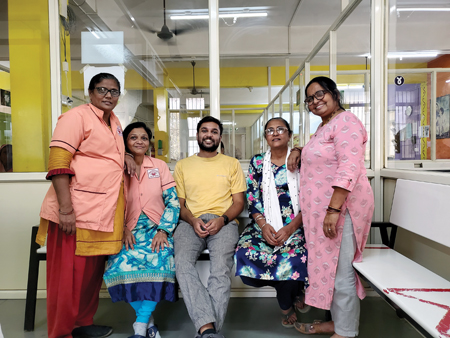
I also wanted to learn to read and write Gujarati, so I took tuition classes nearby in Bharuch, my mother’s hometown. I often practiced my barakshari in the hospital during breaks, for which the nurses poked fun at me, saying I reminded them of their children. In turn, I pestered them to make sure I was writing the letters properly, and they happily taught me the fundamentals.
[Right] The nurses at Kasturba hospital often lovingly teased Kyle for practicing his barakshari in
the hospital, saying he reminded them of their children.
As my Fellowship year came to a close, I worked with my teacher to write a letter in Gujarati to Ba and mailed it home, expressing that I would not be who I am without her. It is my proudest achievement, and I cried watching the video of her reading it, which my mother had recorded and shared with me.
Now after coming back from India, I mostly speak Gujarati with my parents, a priceless gift from my experience that I will cherish forever.
Enjoyed reading Khabar magazine? Subscribe to Khabar and get a full digital copy of this Indian-American community magazine.
blog comments powered by Disqus










